 |
|
| |
|||||||
|
|||||||
|
|||||||
MORE Ruth Adler Schnee: A Life in Design-Design from Life |
|
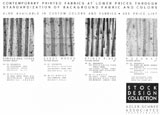 Flyer 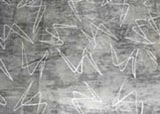 Fancy Free, c. 1950 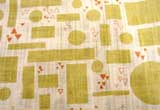 Country Fair  Seedy Weeds 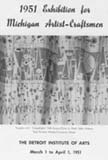 Exhibit Catalog 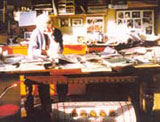 Ruth Adler Schnee in her Southfield, Michigan studio, c. 2000 |
These furnishings fabrics
remain vibrant today, decades after their creation. Just
as intriguing
as the textiles
is Ruth Adler Schnee’s life story. She was a refugee
from Nazi Germany thrust into a new life in America. Fifty
years ago, she succeeded as a female designer in her own
right in a world that is still male-dominated. She forged
a successful career while raising three children with her
husband Edward Schnee. Ruth Adler Schnee maintains a successful
design practice and is as passionate about her career as
any recent graduate. The Adler home was largely destroyed
on Kristallnacht in
November 1938, the night that Nazis attacked synagogues and
Jewish homes and institutions.
Household possessions were pieced
back together and the family shipped
them to the United
States knowing they would have to flee Germany to ensure
their safety.
They settled in Detroit when Ruth was fifteen. Ruth had designed drapes as part of her submission to a house design contest after the war. These designs caught the eye of car dealers who wanted her bold, big, simple designs for the plate-glass windows of new dealerships under construction. The dealers asked her to produce drapes for them, and Ruth and Eddie agreed. Thus, the company Adler Schnee was born in Detroit. Ruth designed her dramatic textiles and Eddie, the Yale graduate, cut the screens and printed them. Ruth took her designs from the life she saw around her. Pins and Needles was inspired by her sewing basket. Country Fair reflects Ruth’s impressions of the Mexican mercados she saw on a trip to Mexico. She found abstracted designs in a patch of weeds, flights of birds, the layers of sedimentary rocks, stacks of cordwood, or railroad tracks. Good quality fabrics were tough to get after the second World War, so she occasionally used tailor's interlining, with its coarser feel and sturdy weave, for her fabrics, as seen in this detail of Seedy Weeds (at left). Inventive and whimsical, Ruth Adler Schnee’s designs were gaining a following. In 1951, her textiles were included in an exhibit of modern craftwork at the Detroit Institute of Arts. Ruth and Eddie (with help from the children) ran Adler Schnee, a store that sold home furnishings of modern design. Ruth worked on important commissions. She collaborated with Buckminster Fuller on the Ford Rotunda (Detroit) in 1952-53 and Minoru Yamasaki in specifying the interior treatments for the World Trade Center in New York City (1970-77). Today, she designs building interiors and creates new woven textiles for Anzea in her studio in Southfield, Michigan. Ruth Adler Schnee has been called a Detroit Treasure. That’s true. But she’s an American legacy as well, having been acknowledged by the Archives of American Art. She might say that design is everywhere we look--if we look we just might see it. We'd argue, however, that it takes Ruth Adler Schnee’s extraordinary eye and uniquely talented hand to turn those patterns of life into timeless art.
|
| Copyright © The Henry Ford ~ http://www.TheHenryFord.org |

